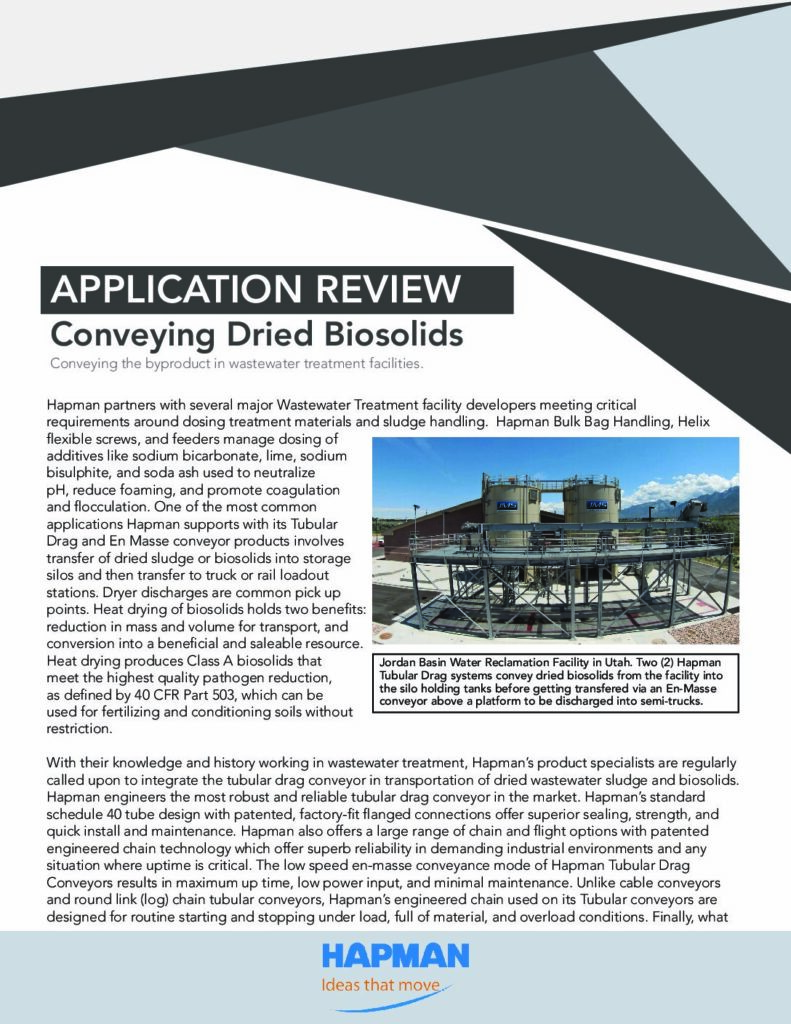Hapman partners with several major Wastewater Treatment facility developers meeting critical requirements around dosing treatment materials and sludge handling. Hapman Bulk Bag Handling, Helix flexible screws, and feeders manage dosing of additives like sodium bicarbonate, lime, sodium bisulphite, and soda ash used to neutralize pH, reduce foaming, and promote coagulation and flocculation. One of the most common applications Hapman supports with its Tubular Drag and En Masse conveyor products involves transfer of dried sludge or biosolids into storage silos and then transfer to truck or rail loadout stations. Dryer discharges are common pick up points. Heat drying of biosolids holds two benefits: reduction in mass and volume for transport, and conversion into a beneficial and saleable resource. Heat drying produces Class A biosolids that meet the highest quality pathogen reduction, as defined by 40 CFR Part 503, which can be used for fertilizing and conditioning soils without restriction.
With their knowledge and history working in wastewater treatment, Hapman’s product specialists are regularly called upon to integrate the tubular drag conveyor in transportation of dried wastewater sludge and biosolids. Hapman engineers the most robust and reliable tubular drag conveyor in the market. Hapman’s standard schedule 40 tube design with patented, factory-fit flanged connections offer superior sealing, strength, and quick install and maintenance. Hapman also offers a large range of chain and flight options with patented engineered chain technology which offer superb reliability in demanding industrial environments and any situation where uptime is critical. The low speed en-masse conveyance mode of Hapman Tubular Drag Conveyors results in maximum up time, low power input, and minimal maintenance. Unlike cable conveyors and round link (log) chain tubular conveyors, Hapman’s engineered chain used on its Tubular conveyors are designed for routine starting and stopping under load, full of material, and overload conditions. Finally, what makes the tubular drag ideal for wastewater sludge and biosolids is the dust tight construction that eliminates the opportunity of some deflagration or explosion conditions, enables maintaining nitrogen blanketing, and eliminates undesirable dust and odor conditions.
For this particular project, Hapman teamed up with Jim Myers & Sons, an OEM that sells systems exclusively for the wastewater treatment industry, to supply an automated dried biosolids handling solution for the Jordan Basin Water Reclamation Facility in Utah. The project involved Tubular Drag Conveyor systems taking 100+ degree Fahrenheit biosolids from the dryer into storage silos and En Masse Conveyor systems discharging from the silos to the loadout facility directly to retractable discharge chutes for discharge into semi trucks. A nitrogen inerting system and dust collection were also involved in the project.
Biosolids were conveyed from the dryer to multiple silos using two Tubular Drag Conveyors. A 157 foot, 4 inch (100 mm) Tubular Drag Conveyor in a gooseneck configuration received the dryer discharge and transferred material to the second 150 foot, 4 inch (100 mm) Tubular Drag Conveyor using a square loop configuration. The conveyors utilized Hapman’s engineered UHMW molded flights with special rivet-less drop forge chain. Schedule 40 pipe was used with special hardened elbows and connected with Hapman’s unique factory-fit locking flange design. All conveyors run continuously, 24 hours/day, 7 days a week and required Class II, Div 2 Explosion rated electrical components.
Due to local ordinance, the silo height was limited and unbale to offer a typical drive-thru load out. Hapman worked closely with CDM, their sister company, to provide an En Masse conveyor system to transport the dried biosolids to the loadout platform. The first En Masse conveyor ran 62 feet horizontally underneath the silos to pick up the biosollids. A second En Masse conveyor came off the first, ran 14 feet horizontally before running another 39 feet at a 40° angle in a L-path to the load out mezzanine. The final En Masse conveyor ran 60 feet horizontally along the mezzanine with multiple discharge chutes for unloading into semi-trucks beneath the mezzanine. The system was able to meet the 20 minute semi loading time using direct silo discharge.
